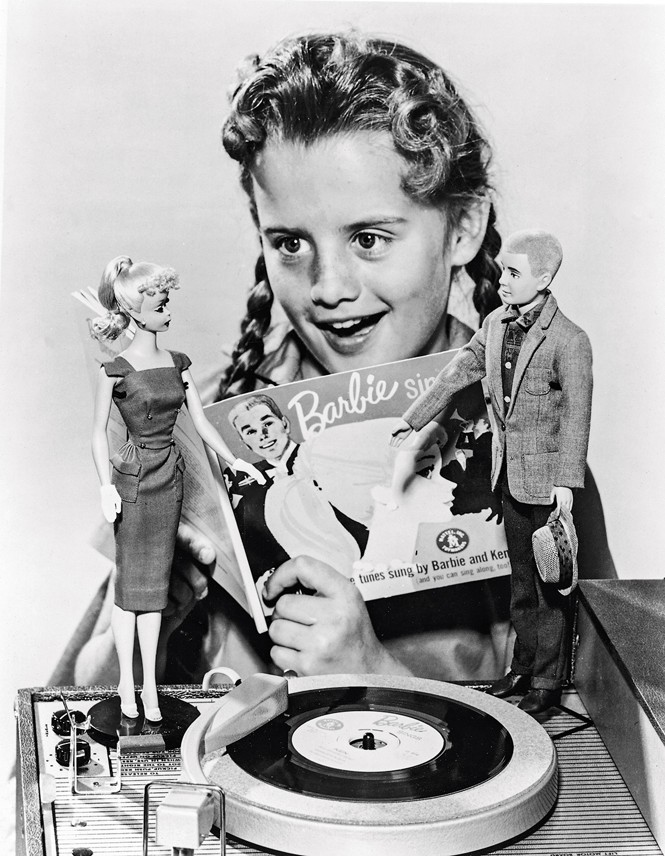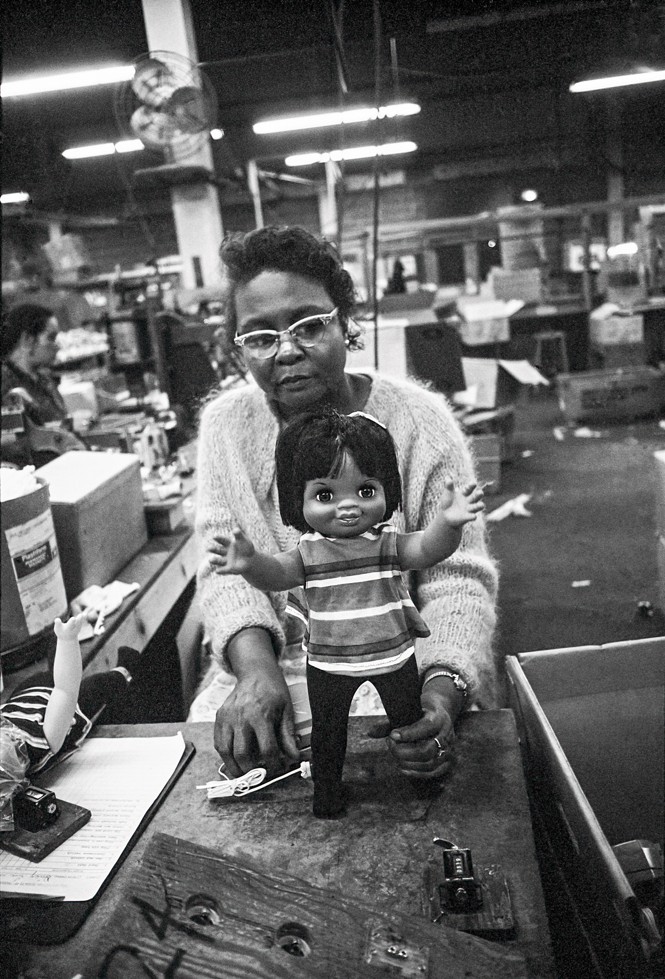
This article was featured in One Story to Read Today, a newsletter in which our editors recommend a single must-read from The Atlantic, Monday through Friday. Sign up for it here.
I noticed. I didn’t make much of it. The day care was closing. I walked over to Imani, took the blue-eyed white doll out of her hands, picked her up off the carpet, and raised her high. She frowned. I smiled. Her frown turned to a smile.
It was the summer of 2017. My partner, Sadiqa, and I had just moved to Washington, D.C. We’d selected our neighborhood, Columbia Heights, because we liked its walkability, access to public transit, and racial diversity. We had enrolled Imani, our 1-year-old daughter, in a day care about 10 minutes from our new home.
The next day, when Sadiqa picked Imani up, she, too, noticed our daughter playing with the white doll. We laughed it off. We expected Imani to start playing with a different doll or toy soon.
But she didn’t. Her frown on day one turned into a sharp “No!” on day two, when Sadiqa tried to take the doll out of her hands, which turned into a car ride of whining on day three, and into an all-out tantrum on day four as she held on firmly to the doll, not wanting to go home.
Sadiqa and I were probably unduly sensitive about the whole situation. But we wondered if our Black child’s attachment to a white doll could mean she had already breathed in what the psychologist Beverly Daniel Tatum has called the “smog” of white superiority.
Maybe our minds were sounding a false alarm. Maybe the eye and skin color and hair texture of the doll had no bearing on why Imani had become attached. I did not know. No one knew. But I did know why the alarm was ringing.
[Read: The never-ending task of shielding Black kids from negative stereotypes]
In 1897, the father of American child psychology, G. Stanley Hall, published his influential A Study of Dolls with Alexander Caswell Ellis. They found that white dolls with “fair hair and blue eyes are the favorites.” Children who played with nonwhite dolls, Hall and Ellis posited, often did so because the dolls’ appearance made them “ ‘funny’ or exceptional.”
Mass-produced toys of all kinds had begun to enter American homes around this time, and many of them exploited racist tropes. Consider the mechanical banks then popular among children. The kids who played with the “Always Did ’Spise a Mule” mechanical bank could push a button and make a Black man fly off a mule face-first, a simulation of racial violence presented, during the lynching era, as a game. Playing with the “Shamrock Bank,” later nicknamed “Paddy and the Pig,” children pulled a lever to make a pig kick a penny into an Irishman’s mouth. The “Reclining Chinaman” mechanical bank featured a Chinese man flashing a handful of aces with a rat at his feet. The cards suggested a deceitful competitive advantage, evoking the idea, widely held at the time, that Chinese immigrants were stealing work from white people.
[Ibram X. Kendi: Opponents of critical race theory are arguing with themselves]
What lessons did these toys teach the children who played with them? For the social scientist Mamie Phipps, such racist caricatures were anything but humorous. Growing up in segregated Arkansas in the 1920s, Phipps lived in the shadow of that racism. “You had to have a certain kind of protective armor about you, all the time,” she later said.
In 1934, Phipps enrolled at Howard University, where she met a psychology master’s student named Kenneth Clark. He encouraged her to major in psychology; the two later married.
The Clarks entered a discipline dominated by eugenicists determined to prove, scientifically, the superiority of the white race. But some social scientists, at least, had come to recognize the dangers of eugenicists’ work. These researchers wanted to use social science, instead, to understand the origins of racist sentiment. Were humans born prejudiced or were they socialized to be that way? This question turned scholarly attention to the racial attitudes of children.
Research in the late 1920s by the social worker and writer Bruno Lasker had demonstrated that “race prejudice,” as he called it, was not an inborn trait but the result of acquired habits—habits that even children as young as 5 years old could develop.

Starting in 1940, the Clarks surveyed 253 Black children ranging in age from 3 to 7. Their goal was to determine whether the children had a concept of racial difference, and if so, whether they expressed racial preference. A little more than half of the children attended segregated nursery schools and public elementary schools in Arkansas, while the rest went to integrated schools in Massachusetts. Each child was shown two dolls with yellow hair and white skin, and two with black hair and dark-brown skin. “Give me the doll you like to play with,” the Clarks instructed the children. Most of the children gave them a white doll. When they prompted the children to “give me the doll that is a nice doll” or “the doll that is a nice color,” most of the children again gave them a white doll. As Kenneth Clark later wrote, the doll study showed “that at an early age Negro children are affected by the prejudices, discrimination, and segregation to which the larger society subjected them.”
[Read: Toys are more divided by gender now than they were 50 years ago]
Social scientists suspected that segregation had negative effects on white children too, even if they lacked the data to prove it empirically (more recent research has borne this out). In 1948, the psychologists Max Deutscher and Isidor Chein surveyed 517 social scientists. Ninety percent, they found, thought that segregation had detrimental effects on the “segregated” group, and 83 percent thought that it had negative effects on the “segregating” group as well. “Enforced segregation builds up attitudes of superiority not based on achievement but upon definitions which cannot be supported when subjected to reality testing,” one psychologist explained.
In 1950, Kenneth Clark presented the doll research, along with Deutscher and Chein’s survey results, at the Mid-century White House Conference on Children and Youth. The following year, as the NAACP mounted the legal challenge to school segregation that would become Brown v. Board of Education, its lawyers asked Clark to submit a similar report. Thirty-two of the era’s leading anthropologists, psychiatrists, psychologists, and sociologists co-signed its conclusion: Racism and segregation “potentially damage the personality of all children.”
On May 17, 1954, the Court issued a unanimous ruling, written by Chief Justice Earl Warren, striking down the “separate but equal” doctrine. “Segregation of white and colored children in public schools has a detrimental effect upon the colored children,” Warren wrote. But the decision overlooked the experts’ argument about segregation’s effects on white children.The Court had struck down segregated schools, but it had not struck down the racist idea that the whiter the school, the better.
Some Americans saw school integration as a chance to facilitate Black assimilation into white American culture. In the ’40s and ’50s, Italian, Jewish, and Irish immigrants had been assimilated or were assimilating into the broader racial category of “white.” But the newly capacious white American identity still had no room for Blackness.
[From the October 2018 issue: Ibram X. Kendi’s “A House Still Divided”]
You can follow this history through the evolution of American toys. By mid-century, toy makers had mostly stopped producing the toys that ridiculed purported ethnic and racial differences; instead, they ignored these differences. Popular games like Chutes and Ladders and Candy Land presented white children on their boxes and boards. In 1959, Mattel introduced the Barbie doll at the American International Toy Fair as a white “Teen-age Fashion Model.” White children continued to play Cowboys and Indians, but in the world of manufactured toys, people of color virtually ceased to exist.
Things started to change in the ’60s. By 1968, James Brown was singing the anthem of a new anti-assimilation consciousness: “Say it loud—I’m Black and I’m proud.” Black had become beautiful during the Black Power movement, which inspired the Red Power, Brown Power, and Yellow Power movements in the late ’60s and the ’70s.
[From the September 1967 issue: Jonathan Kozol’s “Death at an Early Age”]
This environment compelled at least some companies to produce a more diverse assortment of toys. Mattel released its first explicitly Black Barbie in 1968, and Remco’s line of Black dolls appeared that same year. These dolls, though, were mostly marketed to Black children.

Not until the 1980s were nonwhite characters marketed to a wide audience, and then only gradually. A Hispanic Barbie and an Asian Barbie (called “Oriental Barbie”) arrived in that decade; though Hasbro had released a Black G.I. Joe in 1965, it didn’t make an explicitly Hispanic G.I. Joe doll until 2001. Still, by 2019, 55 percent of all Mattel dolls sold globally depicted a historically marginalized group in some way, in terms of either race, ethnicity, religion, gender expression, or body type.
The toy market was coming closer to reflecting America’s diversity. But had children’s attitudes shifted since the Clarks’ era? In 2010, CNN commissioned the child psychologist Margaret Beale Spencer to design an updated version of the doll test. Her team interviewed 133 kids, ages 4, 5, 9, or 10, hailing from both majority-white and majority-Black schools in the New York City and Atlanta areas.
The Clarks had not studied white children, but Spencer did. She found that they displayed a high rate of “white bias,” identifying lighter skin tones with positive attributes and darker hues with negative ones. As the Clarks had found 70 years earlier, Black children, too, displayed some white bias—but far less than their white peers. The reason, Spencer suggested, is because Black parents actively work to protect their children from bias by “reframing messages that children get from society” about racial preference. By contrast, Spencer posited, white parents “don’t have to engage in that level of parenting.”
Regardless of your race, it’s never too early to consider the messages a child is receiving from the world around them. Color blindness is not an option. Research has demonstrated that even at 1 year old, our children notice different skin colors. We can impress upon children the equality of dark and light colors.
At this age, books are a key tool. Among Imani’s favorites were Matthew A. Cherry’s Hair Love, which shows children the beauty of different hair textures, and Joanna Ho’s majestic Eyes That Kiss in the Corners, which emphasizes the equality of differently shaped eyes.
Dolls, too, can make a great teaching tool. We can use dolls to acknowledge difference in skin color but dismiss the racist notions that the darker, the worse. A diverse assortment of toys in general can “open dialogue around prejudice and enable discussion and empathy,” the psychologist Sian Jones has written. “If such toys are not there, the opportunity for this discussion is lost.”
At home, Imani had a wide array of diverse toys. But Sadiqa and I hadn’t thought about their presence at Imani’s day care.

On day five, Sadiqa and I arrived at the day care together. Imani loved when both of us picked her up. When we walked in, she tossed the white doll aside and ran to hug us. “Group hug!” Sadiqa shouted, widening her arms as I did the same. Imani buried her face between our legs. Sadiqa and I made eye contact.
Doll 4, Parents 1.
When Imani released her grip, I walked around the day care and found the large toy chests. I rummaged through the toys and did not come across a single doll that looked Asian, Native, Latino, Middle Eastern, or Black. Every single doll I saw looked white.
Anger overtook me. Not at the day care’s owner—at myself. Imani had been going here for several weeks, and not once did I examine the toy chests.
Imani did not choose to play with the white doll over dolls of color, I realized; she hadn’t had another option. After all these years, how many children still don’t have another option in their toy chests, libraries, or schools? What does the overrepresentation of white dolls tell children about who their caregivers think is important?
We told the owner about the white dolls before leaving for the day. Changes came. But I had failed my doll test.
This essay has been adapted from Ibram X. Kendi’s book How to Raise an Antiracist. It appears in the July/August 2022 print edition with the headline “My Family’s Doll Test.”







